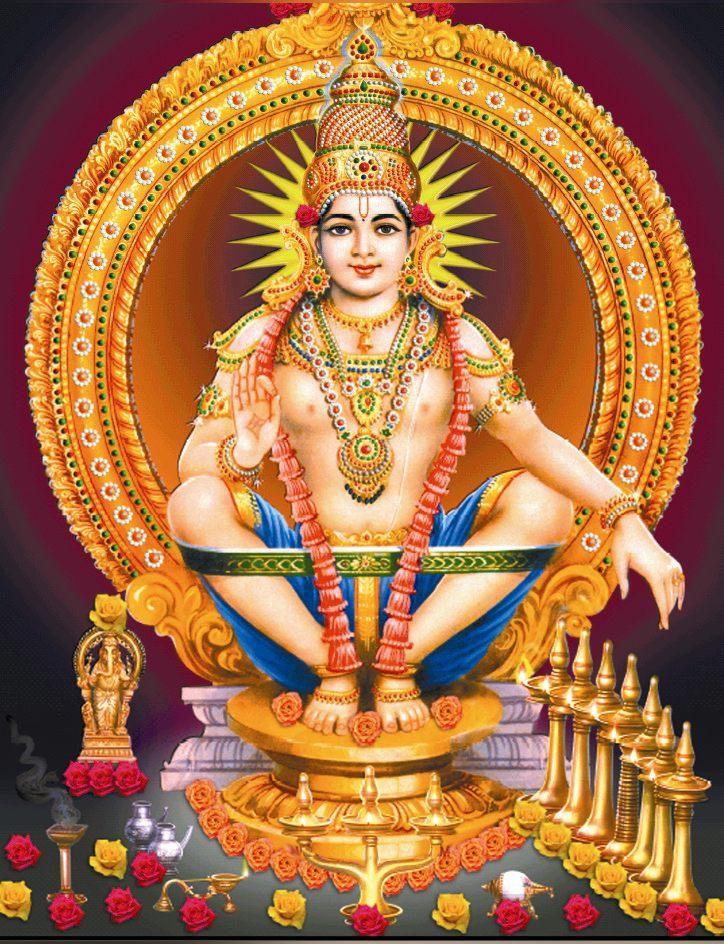Lord Ayyappa – Part 2 – VenuPayyanur
What makes headlines of newspapers in India these days? If you read it carefully one can easily understand some of the major social issues facing our country. Religious intolerance, caste related violence, terrorism, Naxalism, alcoholism, regional and inter-state squabbles, atrocities against women, poverty related issues and rising inequality, over population, corruption, etc. The list can go on…. Is there any solution that our current political class and their leaders can offer to the common man who is running from pillar to post to meet their daily requirements and leading an insecure and frightened existence? Unfortunately the so called political leaders are all busy making money for themselves and we can see scams after scams being unearthed by an overactive media these days!
If there is one solution that can minimise, if not eliminate completely, most of the above evils are the belief in Ayyappa and following the teachings of Ayyappa every day and throughout one’s life. What are those?
To understand the significance of Ayyappa cult and what it can do to humanity, let us all visit the shrine at least once in our life time. This will teach you so many lessons, if put to practice in your daily life; can make a significance difference to you and the society at large. More people following the same can change the society and the country. However one has to follow certain rituals and austerities before undertaking such a journey.
Austerities normally start from the first day of the Malayalam month Vrishchikam. (Mid November). Devotees initiate the vrutham by wearing a Thulasi or a Rudraksha mala. After this ceremony, the pilgrims are addressed as “swami” or “ayyappa” until their completion of the pilgrimage. During the period of vrutham, Devotees are expected to undergo practices of simple living, and absolute cleanliness. The mind and body are to be kept impeccably pure and absolute celibacy is practiced. The devotee is expected to behave in an austere and sober fashion during his vrutham. Total abstinence from all vices like alcohol, tobacco and non-vegetarian food is stipulated. The devotee is expected wear black/blue/saffron clothes. The devotee is expected to pray daily in the mornings and evenings after bathing. The vrutham continues till the pilgrim returns from his pilgrimage to Sabarimala and removes his `mala’ after breaking a coconut and offering prayers. The life of the man can be improved and re-energized by performing Tapas or austerity. Tapas may be performed in body, speech and mind as per ‘Gita’. When man applies himself to these three components, he changes for the better.
On the day of starting the vrutham the devotee shall raise early, bath and offer prayers to family deity, Navagrahas and perform pooja to the holy mala. Then he shall go to temple with his Guru. The mala has to be received from the Guru in midst of chanting of Saranam. After wearing the mala the devotee becomes Lord Ayyappa himself and starts the demands of pious life.
- The devotee shall withdraw from all social activities and spend his time by taking part in praying, poojas, bajans, visiting temples, cleaning temples, feeding the poor, helping the poor/sick and attending religious discourses.
- He shall take only satvic foods and refrain 100% from taking meat, intoxicating drinks / drugs, chewing betel leaves and from smoking.
- He shall bathe twice, if possible thrice, daily and perform pooja by at least chanting 108 Ayyappa Saranam. He shall continuously chant Saranam Ayyappa in mind, both at work and at home.
- He shall not hurt anybody verbally or physically.
- He shall treat all co-devotees as Lord Ayyappa himself and serve them in all the ways.
- He shall not feel proud of the respect and privileges he gets when he is wearing the holy mala. When others prostrate themselves on his feet he shall not feel proud but dedicate the same to Lord Ayyappa and say aloud ‘Lord save everybody for their faith in you’.
- He shall not cause inconvenience to his family members on account on observing the vrutham.
- As he starts his vrutham every year, he shall think that he is doing the same for first time and follow all the rules of the vrutham strictly.
- He shall strictly follow brahmacharya (continence), refrain from sex, thinking of sex, develop passion against all women including his wife, and treat all women with motherly feeling.
- He shall not apply oil to his hair and shall not take bath with oil smeared over his body.
- He shall not sleep on bed but on floor, he shall not use pillow but wooden block, he shall not use footwear but walk with bare feet.
- He shall totally surrender himself to Lord Ayyappa.
What are the benefits of following the above austerities?
- Bring discipline in your life, most essential for success in any walk of life. Today’s youngsters don’t see rising sun, do not eat their meals on time, do not meditate or practice humility in their life. By following all the above austerities, you actually become a different person, and others will respect you for that.
- Eliminate alcoholism, probably the biggest benefit. In fact I have known many who undertake pilgrimage to Sabarimala not because he is a staunch devotee, but hardcore alcoholic and genuinely want to get rid of that dreadful habit.
- Ahimsa is followed by becoming vegetarian and also very good for the body.
- Ego and ego-centric behaviours are kept on check and mind becomes calm and composed. One can feel the serenity around the practitioners and feel safe with such persons.
- Life style one follows during the ‘vrutham’ is the best and purest for anyone wanting to lead a healthy, happy and peaceful life. If possible continue the life style throughout the year.
Visiting the holy shrine during the Makara sankranti is a divine experience in all aspects. After a long journey, you reach Pampa, the holy river. The 4 Km trek to the “Sannidhanam” starts after a ritualistic bath in the river and a visit to the nearby Ganesha temple. Walking barefoot with “irumudikettu” on your head, chanting and singing praises of the lord, you start your long trek to the mountains. Depending on your age, stamina and members of your group, it could take from 30 minutes to three hours to the temple. Thousands of devotees are already in the queue, feverishly chanting “Swamiye, Ayyappa” and your waiting time could be 1, 5 or 10 hours depending upon the day of your visit. But the experience you gain while standing in that queue is unique.
- Thousands of devotees are there, all wearing a black, blue or saffron dhoti, no shirt, Thulasi or Rudraksha mala around their neck, irumudikettu on their heads. You cannot recognize whether they are Hindus or Muslims or any other religion, high cast Brahmans or adivasi, rich or poor, malayalee or Telugu, boss or subordinate, celebrity or common man, all are equal. Probably this is the only place in India where absolute equality and socialism is practiced. Even though you may see few police officers or politicians getting special treatment, that is very few compared to the number of people visiting the shrine or compared to what you see in famous temples like Tirupati or government offices.
- The divine feeling, satisfaction and pleasure you gain at the time of “darshan’ is directly proportional to the pain you undergo during the 41 days of vrutham and the long trek to the mountains and the long wait in the queue.
- In spite of the fact that you have to stand in the queue for a very long time, with the irumudikettu on your head, one can hardly see any anger or frustration among the devotees. Humility and patience is the important virtues one develops during these tapas and if practiced throughout life can benefit immensely.
The very fact that more and more Ayyappa temples are being built across the country and the number of devotees visiting the holy shrine is increasing every year, it is very clear that common man find this extremely useful and beneficial to their life. It helps them grow mentally, spiritually, intellectually and physically. It helps them to lead a healthy and happy life. It reduces animosity between people and one learns to respect others irrespective of their religion, cast, financial or social status. When you address others are ‘Swami’ meaning Master, you learn humility. Let us all become the devotee of lord Ayyappa, if not for religious reasons but for the great lessons it teaches in our way of life, socialistic and secularist practices.
‘Swamiye saranam’


Sree Bhoothanaathopakhyaanam was the first ever work to be printed about Ayyappa Swami in any language. Published in 1929, this Malayalam Kilippaattu brought the story of Ayyappa to popular attention for the first time in literature. It is from this work that the traditions and procedures of the pilgrimage came to be followed. The Ayyappa Documentation Project of the Sabari Sharanasramam Trust followed the book up and managed to obtain a copy of the 1947 edition. The book is now reprinted by them and copies are again available for the first time after 1947. The book is priced at Rs.100/-.
Only a few copies are available on first-come basis.
For copies:
Phone: 04842355575, 9447105579, 9567904159
Email: [email protected]
[email protected]